Home and Garden
How to Make Green Manure for Your Garden
by Tristan Kavanagh
Many individuals who garden are aware of the hazards that animals have on the environment. Resulting in the use of plant-based fertilisers as opposed to animal manure. Whilst most organic fertilisers are animal based, such as blood and bone or manure. This results in individuals looking for plant-based alternatives, hence the recent growth in plant-based fertilisers as manure alternatives.
Using plant-based fertilisers
Whilst using plant-based fertiliser can be a perfect alternative, it’s important to know that when you are using plant-based fertilisers, you are essentially feeding soil microbes, which will transform that food into nutrients for your plants. This process works best when the soil is warm and active and enriched with compost, or decomposing mulch.
Cover cropping with Pellets
For my garden I tend to never leave the soil bare and to keep it covered all year round. A little while ago now when reading online, and learnt about the benefits of pellets sold as food supplements to goats and horses, and their impact on your soil quality of your garden.
After doing some more research, my temptations got the better of me and I had to see if I was missing out on something. The ones I tried and worked will little alfalfa pellets. High levels of nitrogen mean they rot fast when mixed into the soil. As they grow when exposed to moisture it’s the perfect slow release of nutrients your soil is after. My garden had an exceptional year.
I have tried my luck with other animal feeds such as chicken feed and had some positive results as well. When apply different types of pellets I was cautious of the nitrogen content as I didn’t want to burn my plants. Grain feed for animals have been recommended as fertiliser for many years. If you’re interested in trying it out, it’s important to read the label to ensure there’s no other chemicals that won’t benefit your soil, these are things such as fats and oils.
Plant-based liquid fertilisers
When spring gets under way, your garden will start to take off. And some liquid fertiliser can go a long way and works wonders. Unlike granular fertiliser, liquid fertiliser is effective at providing your plants with quick nutrients. Another great aspect of liquid fertiliser is you can give your plants a controlled boost, this will prevent harm to your garden from over fertilising.
Making liquid fertiliser
Living on the Australian coast means I have access to plenty of seaweed. Seaweed is packed full of nutrients such as potassium, nitrogen, phosphate and magnesium. If you have access to beach that has seaweed grab a bit on you next visit, you won’t need much. Rinse it down well to clean of the salt, then put it in a bucket of water with a lid. Place in a dark place and let the seaweed decompose This process takes about 8 weeks, (mind you it gets a bit smelly) Once this is done, the liquid is ready for your garden.
About the Author
Tristan is a writer from Sydney Gardeners and is passionate about sustainability and the environment. His passion has grown from his experience working in nature. You can view more of his works here.





